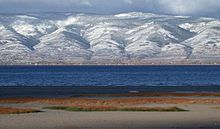Geography of Idaho
The states of Washington and Oregon are to the west, Nevada and Utah are to the south, and Montana and Wyoming are to the east.
The waters of the Snake River run through Hells Canyon, the deepest gorge in the United States.
Idaho's highest point is Borah Peak, 12,662 ft (3,859 m), in the Lost River Range north of Mackay.
The forest is in an area known as the Idaho Cobalt Belt, which consists of a 34 miles (55 km) long geological formation of sedimentary rock that contains some of the largest cobalt deposits in the U.S.[6] Idaho has two time zones, with the dividing line approximately midway between Canada and Nevada.
Although the state's western border is about 330 miles (530 km) from the Pacific Ocean, the maritime influence is still felt in Idaho; especially, in the winter when cloud cover, humidity, and precipitation are at their maximum extent.
This influence has a moderating effect in the winter where temperatures are not as low as would otherwise be expected for a northern state with predominantly high elevations.
[9] The maritime influence is least prominent in the state's eastern part where the precipitation patterns are often reversed, with wetter summers and drier winters, and seasonal temperature differences are more extreme, showing a more semi-arid continental climate.
[10] Idaho can be hot, although extended periods over 98 °F (37 °C) are rare, except for the lowest point in elevation, Lewiston, which correspondingly sees little snow.







